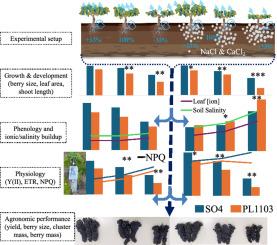Modulation of phenology and agronomical performance of Syrah grafted on two rootstocks under combined salinity and water stress conditions: A three-year field study
IF 6.8
Q1 PLANT SCIENCES
引用次数: 0
Abstract
Climate change is challenging global viticulture through increasing drought and salinization, making rootstock selection critical. However, field-based understanding of rootstock-mediated stress responses remains limited. Here, we examined the mediation of Sélection Oppenheim 4 (SO4) and 1103 Paulsen (PL1103) rootstocks on Syrah grapevines' responses under combined water and salinity stress over 3 years (2022‒2024). We observed that the soil electrical conductivity (ECe1:1) increased from 2.09 to 8 dS m−1 under severe stress, while soil chloride concentration ([Cl⁻]) reached 716.5 mg L−1 in Syrah grafted onto PL1103 (SY_PL1103) and 954.9 mg L−1 in Syrah grafted onto SO4 (SY_SO4), compared with 90‒162 mg L‒1 under the control conditions coupled with varied leaf [Cl⁻] between grafts. Salinity delayed flowering time by 7‒11 days when the ECe1:1 exceeded 2.79 dS m‒1 in SY_PL1103 and 1.99 dS m‒1 in SY_SO4. Nevertheless, SY_SO4 maintained greater physiological performance with 56.8 % greater photosystem II efficiency, 48.71 % greater electron transport rate, and higher non-photochemical quenching across conditions than SY_PL1103, effectively managing excess light as heat to prevent photodamage. SY_SO4 vines exhibited a significantly lower yield reduction (36.3 % vs 56.4 % in SY_PL1103) and better salinity tolerance, with yield decreasing by only 2.63 t ha−1 per unit increase in ECe1:1 above the threshold (SY_PL1103 = 3.47 dS m−1 and SY_SO4 = 2.71 dS m−1) compared with 7.78 t ha−1 in SY_PL1103. SY_SO4 showed smaller photosynthetic and morphological changes to combined stressors, with higher soil and lower leaf [Cl−] indicating better ion exclusion, offering valuable insights and practical solutions for resilient grapevine breeding and vineyard management strategies in saline-prone arid regions.

盐度和水分联合胁迫条件下两根砧木嫁接西拉物候和农艺性状的调控:为期三年的田间研究
气候变化通过增加干旱和盐碱化正在挑战全球葡萄栽培,使砧木选择至关重要。然而,基于实地的对砧木介导的胁迫反应的理解仍然有限。本研究通过3年(2022-2024年)的时间,研究了ssamlection Oppenheim 4 (SO4)和1103 Paulsen (PL1103)砧木对西拉(Syrah)葡萄在水盐联合胁迫下的响应。我们观察到,在严重胁迫下,土壤电导率(ECe1:1)从2.09增加到8 dS m−1,而嫁接在PL1103 (SY_PL1103)上的西拉(SY_SO4)上的西拉(954.9 mg L−1)的土壤氯浓度([Cl - 9])达到716.5 mg L−1,而嫁接在不同叶子[Cl - 9]的对照条件下为90-162 mg L - 1。当SY_PL1103的ECe1:1和SY_SO4的ECe1:1分别超过2.79 dS - m-1和1.99 dS - m-1时,花期延迟7 ~ 11 d。然而,与SY_PL1103相比,SY_SO4保持了更高的生理性能,光系统II效率提高了56.8%,电子传递率提高了48.71%,不同条件下的非光化学猝灭也更高,有效地将多余的光转化为热来防止光损伤。SY_SO4表现出较低的减产幅度(36.3%比SY_PL1103的56.4%)和较好的耐盐性,ECe1:1高于阈值(SY_PL1103 = 3.47 dS m−1和SY_SO4 = 2.71 dS m−1),单株产量仅下降2.63 t ha−1,而SY_PL1103为7.78 t ha−1。SY_SO4在综合胁迫下表现出较小的光合作用和形态变化,土壤浓度越高,叶片[Cl−]含量越低,表明其离子排异能力越强,这为干旱盐渍化地区的抗逆性葡萄育种和葡萄园管理策略提供了有价值的见解和实用的解决方案。
本文章由计算机程序翻译,如有差异,请以英文原文为准。
求助全文
约1分钟内获得全文
求助全文
来源期刊

Plant Stress
PLANT SCIENCES-
CiteScore
5.20
自引率
8.00%
发文量
76
审稿时长
63 days
期刊介绍:
The journal Plant Stress deals with plant (or other photoautotrophs, such as algae, cyanobacteria and lichens) responses to abiotic and biotic stress factors that can result in limited growth and productivity. Such responses can be analyzed and described at a physiological, biochemical and molecular level. Experimental approaches/technologies aiming to improve growth and productivity with a potential for downstream validation under stress conditions will also be considered. Both fundamental and applied research manuscripts are welcome, provided that clear mechanistic hypotheses are made and descriptive approaches are avoided. In addition, high-quality review articles will also be considered, provided they follow a critical approach and stimulate thought for future research avenues.
Plant Stress welcomes high-quality manuscripts related (but not limited) to interactions between plants and:
Lack of water (drought) and excess (flooding),
Salinity stress,
Elevated temperature and/or low temperature (chilling and freezing),
Hypoxia and/or anoxia,
Mineral nutrient excess and/or deficiency,
Heavy metals and/or metalloids,
Plant priming (chemical, biological, physiological, nanomaterial, biostimulant) approaches for improved stress protection,
Viral, phytoplasma, bacterial and fungal plant-pathogen interactions.
The journal welcomes basic and applied research articles, as well as review articles and short communications. All submitted manuscripts will be subject to a thorough peer-reviewing process.
 求助内容:
求助内容: 应助结果提醒方式:
应助结果提醒方式:


